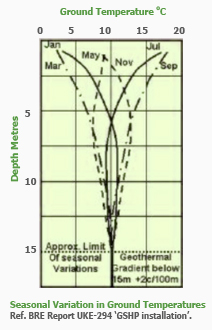
Ground Source Heat
Benefits
Process
→ Assessment of Project Design
→ Reducing the Heating Requirement
→ Delivering the Warmth
→ Providing the Heat
→ Your Final Saving
Frequently Asked Questions
Case Histories
Assessment of Project Design
The first step of the project is to understand the client's requirements. We can then go on to assess the building and the ground beneath the building, which will all contribute to the overall design and cost of the project.The Client's Requirements
Before considering the heating system, we must understand the client's requirements. For example: What temperature is required in each room? What floor coverings are required? Are fires or wood burning stoves going to be installed? Are there are other particular requirements or constraints?
Wherever possible we would recommend underfloor heating, but low surface temperature radiators are an alternative, as are reheat batteries in the incoming air flow.
Heat loss calculation
The analysis of the fabric of the building enables us to accurately calculate the heat loss and to decide whether any improvements are necessary or desirable.
Geology and Hydrogeology
 The amount of heat that can be extracted from the ground is dependant upon a number of factors, such as:
The amount of heat that can be extracted from the ground is dependant upon a number of factors, such as:• The temperature of the ground
• The thermal capacity of the strata
• The thermal conductivity of the strata
• The surface area of the receptor
The first 15m of strata under the ground is subject to seasonal temperature changes, as it is heated by the sun and cooled by the air.
The next 85 metres is at constant and consistent temperature, which is dependant upon the geographic location of the site. In general terms it is warmer in Scotland than in the south of England.
Deeper than 100m the ground temperature rises by 1°C for every 50m metres of depth, due to the geothermal heat conducted from the core of the earth.
If a number of geothermal installations are required, the amount of heat available can be ascertained by installing a trial installation and measuring the heat extracted and the resultant temperature drop in the ground over a sustained period. Coupled with a detailed understanding of the various strata gained through detailed logging of the tailings obtained during the drilling of the trial borehole, an accurate estimate of the sustainable heat capacity of the borehole can be calculated.
 For most installations a detailed desk study is undertaken. Using geological maps, historic maps, borehole logs, mining plans and well records the nature of the strata under the site can be ascertained. By extrapolating the fault lines in the locality of the site, the depths of the strata can be estimated. During the drilling of the boreholes a detailed examination of the tailing enables the desk study to be validated, and thus the thermal properties of the borehole can be estimated and the depth and number of boreholes ascertained.
For most installations a detailed desk study is undertaken. Using geological maps, historic maps, borehole logs, mining plans and well records the nature of the strata under the site can be ascertained. By extrapolating the fault lines in the locality of the site, the depths of the strata can be estimated. During the drilling of the boreholes a detailed examination of the tailing enables the desk study to be validated, and thus the thermal properties of the borehole can be estimated and the depth and number of boreholes ascertained.
If there is an aquifer under the site and the volume of water available is adequate and sustainable, the calculation is simplified. The amount of heat that can be extracted is dependant upon the temperature of the water and the volume pumped.
Project Costing
A detailed proposal is presented to the client, which will outline the way the building can be most efficiently heated and ventilated. Next Stage





